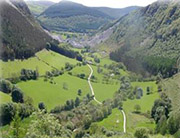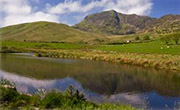Where are we?
The project is based in Bangor, in North Wales, and near Aberystwyth in West Wales.
 West Wales has a long tradition of beekeeping even though it is a marginal area for bees. The high rainfall means that the colony must be able to take advantage of the few sunny days available to gather a crop of honey. Bees that will survive in this environment will be hardy, frugal, will work under marginal conditions, and be able to adjust their brood laying pattern to suit prevailing conditions.
West Wales has a long tradition of beekeeping even though it is a marginal area for bees. The high rainfall means that the colony must be able to take advantage of the few sunny days available to gather a crop of honey. Bees that will survive in this environment will be hardy, frugal, will work under marginal conditions, and be able to adjust their brood laying pattern to suit prevailing conditions.
 We believe that Wales represents a reservoir of genetic diversity of the native honeybee (old beekeeping reports suggest that “Isle of Wight” and other diseases did not reach into many of the more isolated parts of Wales), while there are many reports of feral honeybee colonies which persist in the wild for many years (whereas it is widely believed that native wild bees will have died out after the spread of the varroa mite across Europe).
We believe that Wales represents a reservoir of genetic diversity of the native honeybee (old beekeeping reports suggest that “Isle of Wight” and other diseases did not reach into many of the more isolated parts of Wales), while there are many reports of feral honeybee colonies which persist in the wild for many years (whereas it is widely believed that native wild bees will have died out after the spread of the varroa mite across Europe).
 These wild colonies (as well as, indeed, some managed colonies) may represent a useful source of genetically controlled varroa resistance traits. We are also fortunate in Wales in having fewer problems facing our bees: for example, high intensity agriculture is absent so bees are not facing nutritional problems caused by monoculture, or pesticide residues.
These wild colonies (as well as, indeed, some managed colonies) may represent a useful source of genetically controlled varroa resistance traits. We are also fortunate in Wales in having fewer problems facing our bees: for example, high intensity agriculture is absent so bees are not facing nutritional problems caused by monoculture, or pesticide residues.
 This leaves us free to concentrate on breeding issues. West Wales also contains a number of narrow valleys winding into the mountains that make good isolated locations for controlling the breeding of selected queens with selected drones.
This leaves us free to concentrate on breeding issues. West Wales also contains a number of narrow valleys winding into the mountains that make good isolated locations for controlling the breeding of selected queens with selected drones.